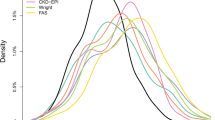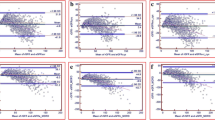Abstract
Background
Serum creatinine (SCr) and Cockcroft-Gault creatinine clearance (CG CrCL) are used to estimate glomerular filtration rate (GFR). Other markers have been proposed including serum cystatin C (cysC) and the Modification of Diet in Renal Disease (MDRD) study equation.
Patients and Methods
We have compared the diagnostic performances of SCr, cysC, CG CrCL, and the MDRD equation in 144 cancer patients. For reference we used either the measured or the predicted carboplatin clearance, which is around the GFR+25 mL/min.
Results
CysC was more sensitive than SCr (70.1% vs 13.4%) but was not very specific (61% for a cut-off =0.95 mL). CysC values were higher in 40 cancer patients vs 40 healthy controls with a similar and normal mean CG CrCL (1.08 vs 0.71 mg/L; p<0.001). CG and the MDRD equations gave similar values for Pearson's coefficient, ROC-plot AUC, and precision, except for patients with poor general status, where the MDRD equation was better (MAPE: 12.4% vs 19.6%, p<0.001; R.: 0.908 vs 0.813).
Conclusions
In cancer patients, cysC is a more sensitive indicator of the glomerular filtration rate than SCr, but its diagnostic performance is lower than for CG CrCL. There may be no advantage in replacing the CG equation by the MDRD equation except for patients with severe malnutrition and/or inflammation.
Similar content being viewed by others
References
Cockeroft D, Gault M. Prediction of creatinine clearance from serum creatine. Nephron 1976; 16(1):31–41.
Jelliffe RW. Letter; Creatinine clearance: bedside estimate. Ann Intern Med 1973; 79(4):604–605.
Levey AS, et al. A more accurate method to estimate glomerular filtration rate from serum creatinine: a new prediction equation. Modification of Diet in Renal Disease Study Group. Ann Intern Med 1999; 130(6):461–470.
Martin L, et al. Improvement of the Cockcroft-Gault equation for predicting glomerular filtration in cancer patients. Bull Cancer 1998; 85(7):631–636.
Wright JG, et al. Estimation of glomerular filtration rate in cancer patients. Br J Cancer 2001; 84(4):452–459.
Murray PT, Ratain MJ. Estimation of the glomerular filtration rate in cancer patients: a new formula for new drugs. J Clin Oncol 2003; 21(14):2633–2635.
Newman DJ. Cystatin C. Ann Clin Biochem 2002; 39(Pt 2):89–104.
Dharnidharka VR, Kwon C, Stevens G. Serum cystatin C is superior to serum creatinine as a marker of kidney function: a meta-analysis. Am J Kidney Dis 2002; 40(2):221–226.
Stabuc B, Vrhovec L, Stabuc-Silih M, Cizej TE. Improved prediction of decreased creatinine clearance by serum cystatin C: use in cancer patients before and during chemotherapy. Clin Chem 2000; 46(2):193–197.
Al Tonbary YA, Hammad AM, Zaghloul HM, Sayed HE, Abu-Hashem E. Pretreatment cystatin C in children with malignancy: can it predict chemotherapy-induced glomerular filtration rate reduction during the induction phase? J Pediatr Hematol Oncol 2004; 26(6):336–341.
Bardi E, Brook I, Olah AV, Olah E, Kappelmayer J, Kiss C. Cystatin C is a suitable marker of glomerular function in children with cancer. Pediatr Nephrol 2004; 19(10):1145–1147.
Hoppe AP, et al. Serum cystatin C is a better marker of topotecan clearance than serum creatinine. Clin Cancer Res 2005; 11(8):3038–3044.
Thomas F, et al. Cystatin C as a new covariate to predict the renal elimination of drugs: application to carboplatin. Clin Pharmacokinetics 2005, in press.
Calvert AH, et al. Carboplatin dosage: prospective evaluation of a simple formula based on renal function. J Clin Oncol 1989; 7(11):1748–1756.
Duffull SB, Robinson BA. Clinical pharmacokinetics and dose optimisation of carboplatin. Clin Pharmacokinet 1997; 33(3):161–183.
Chatelut E, et al. A limited sampling strategy for determining carboplatin AUC and monitoring drug dosage. Eur. J. Cancer 2000; 36(2):264–269.
Rule AD, Larson TS, Bergstralh EJ, Slezak JM, Jacobsen SJ, Cosio FG. Using serum creatinine to estimate glomerular filtration rate: accuracy in good health and in chronic kidney disease. Ann Intern Med 2004; 141(12):929–937.
Wuyts B, et al. Reevaluation of formulas for predicting, creatinine clearance in adults and children, using compensated creatinine methods. Clin Chem 2003; 49(6 Pt 1):1011–1014.
ANAES. Diagnostic de l'insuffisance rénale chez l'adulté. ANAES: recommandation, pour la pratique clinique 2002.
K/DOQI clinical practice guidelines for chronic kidney disease: evaluation, classification, and stratification. Kidney Disease Outcome Quality Initiative. Am J Kidney Dis 2002; 39(2 Suppl 2):S1–246.
Seronie-Vivien S, et al. [Improving the interlaboratory variation for creatinine serum, assay]. Ann Biol Clin (Paris) 2004; 62(2):165–175.
Vervoort G, Willems HL, Wetzels JF. Assessment of glomerular filtration rate in healthy subjects and normoal-buminuric diabetic patients: validity of a new (MDRD) prediction equation. Nephrol Dial Transplant 2002; 17(11):1909–1913.
Kos J, Stabuc B, Cimerman N, Brunner N. Serum cystatin C, a new marker of glomerular filtration rate, is increased during malignant progression. Clin Chem 1998; 44(12):2556–2557.
Nishikawa H, et al. The role of cathepsin B and cystatin C in the mechanisms of invasion by ovarian cancer. Gynecol Oncol 2004; 92(3):881–886.
Strojan P, Svetic B, Smid L, Kos J. Serum cystatin C in patients with head and neck carcinoma. Clin Chim Acta 2004; 344(1–2):155–161.
Mojiminiyi OA, Marouf R, Abdella N, Kortom M, Abdul-Razzak R. Serum concentration of cystatin C is not affected by cellular proliferation in patients with proliferative haematological disorders. Ann Clin biochem 2002; 39(Pt 3):308–310.
Kos J, et al. Cysteine proteinase inhibitors stefin A, stefin B, and cystatin C in sera from patients with colorectal cancer: relation to prognosis. Clin Cancer Res; 2000; 6(2):505–511.
Sokol JP, Schiemann WP. Cystatin C antagonizes transforming growth factor beta signaling in normal and cancer cells. Mol Cancer Res 2004; 2(3):183–195.
Solem M, Rawson C, Lindburg K, Barnes D. Transforming growth factor beta regulates cystatin C in serum-free mouse embryo (SFME) cells. Biochem Biophys Res Commun 1990; 172(2):945–951.
Knight EL, et al. Factors influencing serum cystatin C levels other than renal function and the impact on renal function measurement. Kidney Int 2004; 65(4):1416–1421.
Author information
Authors and Affiliations
Corresponding author
Rights and permissions
About this article
Cite this article
Séronie-Vivien, S., Toullec, S., Malard, L. et al. Contribution of the MDRD equation and of cystatin C for renal function estimates in cancer patients. Med Oncol 23, 63–73 (2006). https://doi.org/10.1385/MO:23:1:63
Received:
Accepted:
Issue Date:
DOI: https://doi.org/10.1385/MO:23:1:63




